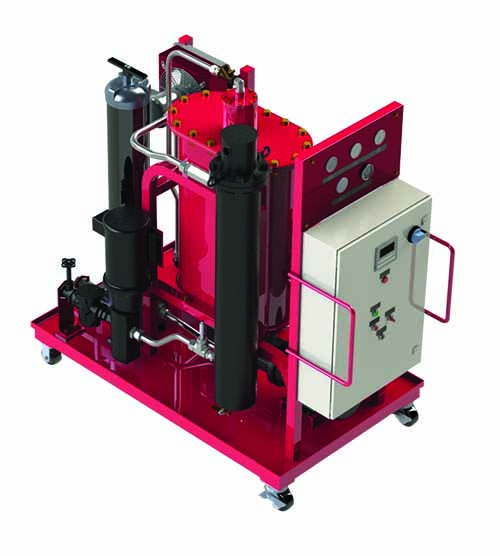You might be surprised to hear that oil and water do mix. Of course, they won’t mix when poured together in a glass and stirred with a spoon. But forces at play to destroy your hydraulic system find ways to allow much more water to saturate and emulsify with your innocent hydraulic oil. Heat, oxidation and chemical contamination increase the likelihood of oil taking on water.

Water, of course, does your hydraulic system no good. It reduces lubricity, increases corrosion and increases oxidation, to name a few pitfalls. In addition, free water settles to the bottom of a reservoir and gets trapped by specialty filter elements, or other specialty equipment. However, saturated water is more difficult to remove because it is essentially humidity inside the oil.
The amount of water held in saturation depends partly on temperature and pressure. Hotter oil under pressure easily holds more water in saturation, but the problem occurs when the oil cools again, and free water releases itself from the oil. Free water does the most damage, so awareness of your system’s condition and the tendency of its water to condense might change how you approach your treatment of the problem.
If ambient conditions encourage perennial water contamination, a vacuum dehydrator offers one of the best solutions to preventing humidity from ever condensing into free water. Water’s boiling point varies with pressure, so automotive cooling systems are pressurized to allow the coolant temperature to rise well above the boiling point at sea level. Conversely, water under a vacuum boils more readily (fun fact: water in the presence of a near-complete vacuum will boil at freezing temperatures).
The relationship between pressure and boiling allows fluid power designers to remove saturated water by first heating the oil and then exposing it to a vacuum. The moderate heat (110-160° F less), when applied to 20 in.-Hg or less, easily boils the water out of the oil while the vacuum pump carries it away. Sure, you could boil the water out at 212°F, but you’d expose the oil to irreversible oxidation damage. Instead, the vacuum dehydrator offers a safe and effective method to lower dissolved water to less than 10% and remove free water entirely.
The vacuum dehydrator looks much like a sophisticated filter cart, and indeed they are often portable. The machine works much like an offline filter, where you insert a suction hose into your reservoir while you run the fluid through the machine and back into the tank with dry oil. A single machine will support many power units but could also dedicate itself to a single problematic machine.
A vacuum dehydrator doesn’t have to operate on live machinery and may also dry out stored oil in drums or tanks before filling a power unit. In fact, there’s no reason a dehydrator couldn’t be combined with high-efficiency filtration to provide your hydraulic machine with the cleanest, driest fluid every time you need to top of the tank.
Filed Under: Engineering Basics, Filtration/Contamination Control, Fluid Conditioning, Sealing & Contamination Control Tips